MSTU2160: Film and Television History Essay, Semester 2, 2018
VerifiedAdded on 2022/11/30
|9
|2272
|52
Essay
AI Summary
This essay provides an in-depth analysis of the silent film era, examining its significance in the development of cinematography and its influence on the American film industry. It begins by discussing the pioneering efforts to popularize cinema and the experimental filmmaking techniques of the time. The essay highlights the impact of Thomas Edison's Kinetoscope and the early short films, as well as the contributions of the Lumiere brothers in Europe. It then explores the influence of French silent cinema and the disruption caused by World War I, which shifted the focus to American filmmaking. The essay examines the innovations introduced by D.W. Griffith's "Birth of a Nation" and the subsequent emergence of film studios, including the German Ufa studio and the American studio system. The essay concludes by emphasizing the non-American influences on the creation of American film studios and their lasting impact on filmmaking and popular culture. The essay also discusses key figures like Charlie Chaplin and the transition from independent filmmaking to the collectivization of efforts that led to the studio system. The essay also provides a detailed overview of the references used.
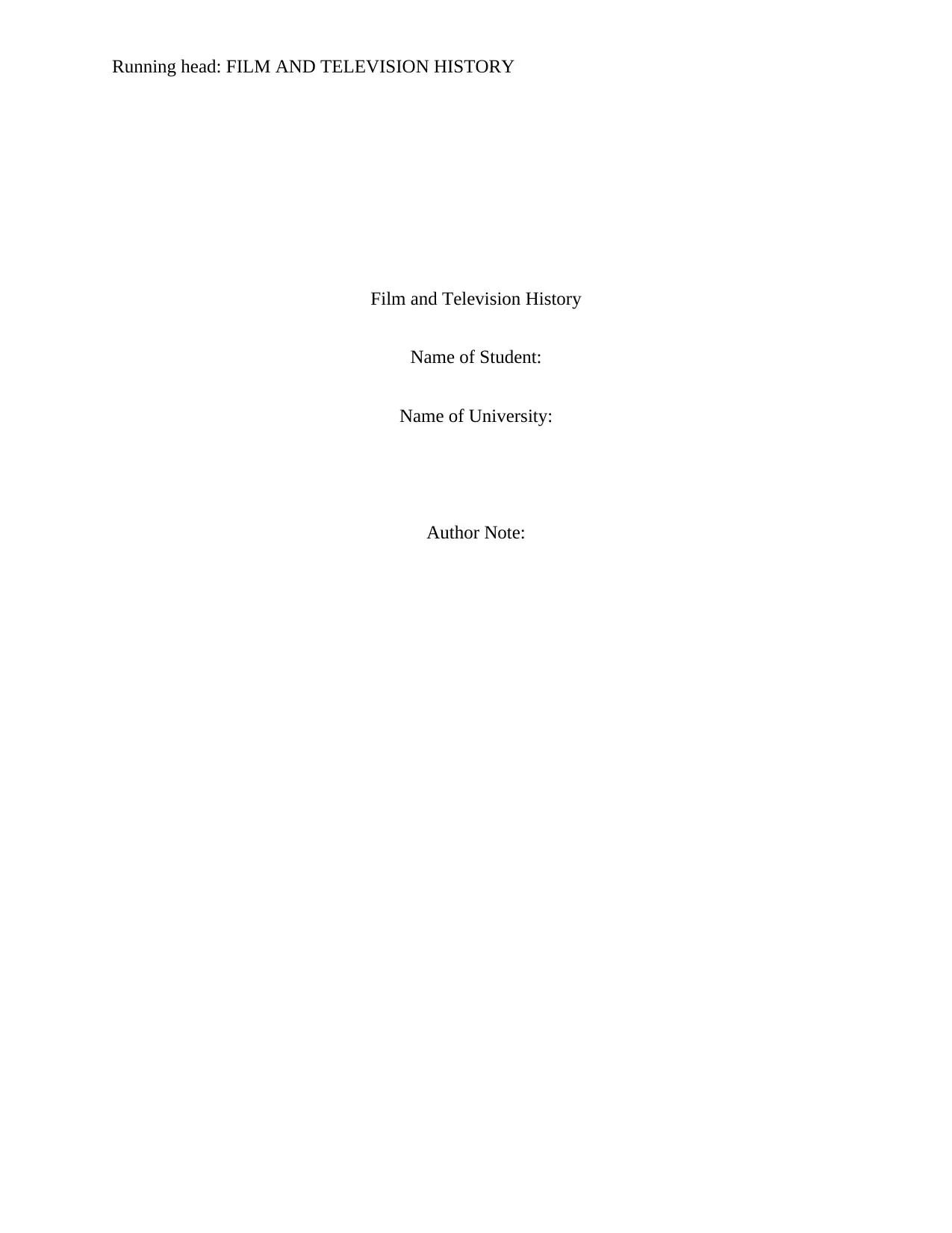
Running head: FILM AND TELEVISION HISTORY
Film and Television History
Name of Student:
Name of University:
Author Note:
Film and Television History
Name of Student:
Name of University:
Author Note:
Paraphrase This Document
Need a fresh take? Get an instant paraphrase of this document with our AI Paraphraser
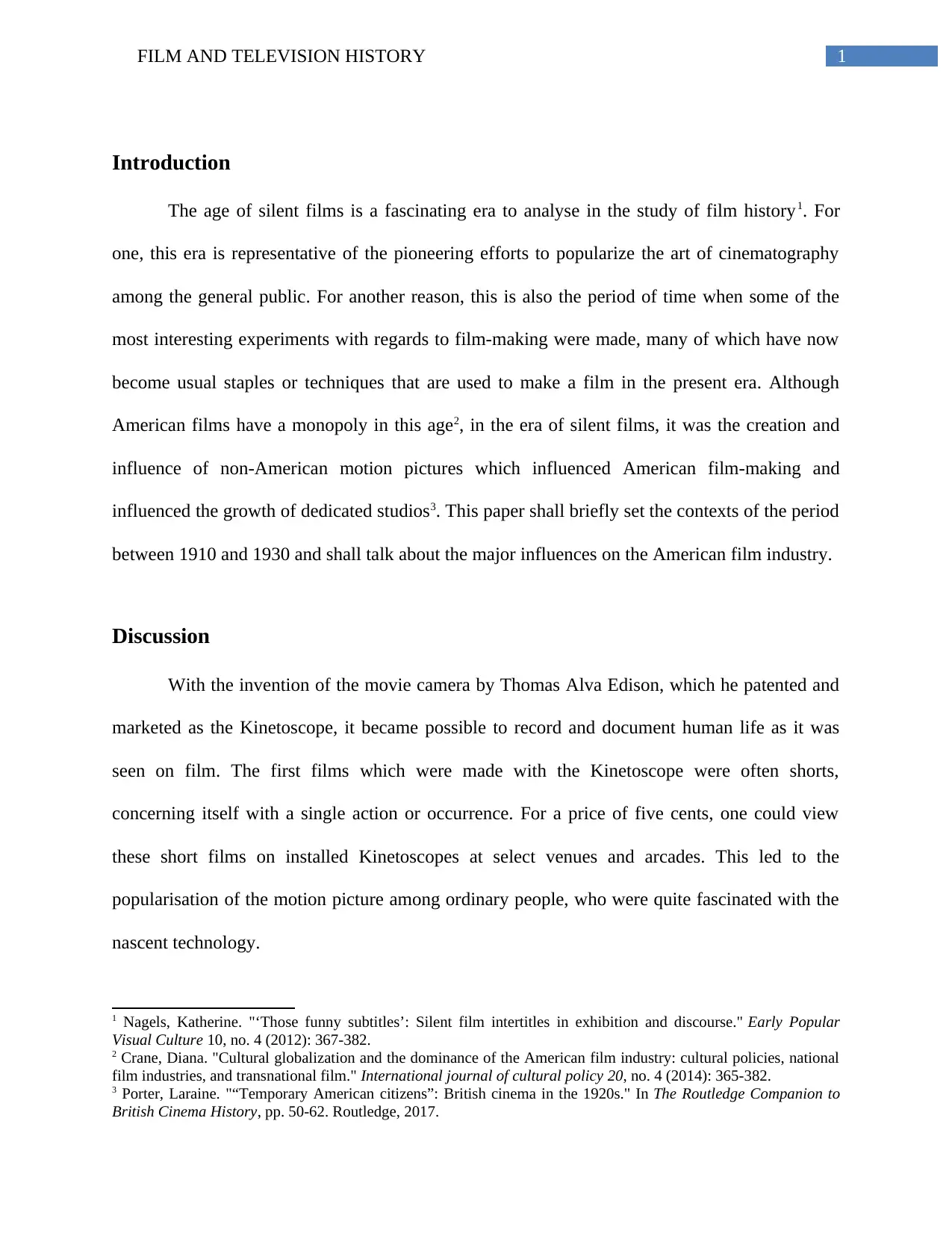
1FILM AND TELEVISION HISTORY
Introduction
The age of silent films is a fascinating era to analyse in the study of film history1. For
one, this era is representative of the pioneering efforts to popularize the art of cinematography
among the general public. For another reason, this is also the period of time when some of the
most interesting experiments with regards to film-making were made, many of which have now
become usual staples or techniques that are used to make a film in the present era. Although
American films have a monopoly in this age2, in the era of silent films, it was the creation and
influence of non-American motion pictures which influenced American film-making and
influenced the growth of dedicated studios3. This paper shall briefly set the contexts of the period
between 1910 and 1930 and shall talk about the major influences on the American film industry.
Discussion
With the invention of the movie camera by Thomas Alva Edison, which he patented and
marketed as the Kinetoscope, it became possible to record and document human life as it was
seen on film. The first films which were made with the Kinetoscope were often shorts,
concerning itself with a single action or occurrence. For a price of five cents, one could view
these short films on installed Kinetoscopes at select venues and arcades. This led to the
popularisation of the motion picture among ordinary people, who were quite fascinated with the
nascent technology.
1 Nagels, Katherine. "‘Those funny subtitles’: Silent film intertitles in exhibition and discourse." Early Popular
Visual Culture 10, no. 4 (2012): 367-382.
2 Crane, Diana. "Cultural globalization and the dominance of the American film industry: cultural policies, national
film industries, and transnational film." International journal of cultural policy 20, no. 4 (2014): 365-382.
3 Porter, Laraine. "“Temporary American citizens”: British cinema in the 1920s." In The Routledge Companion to
British Cinema History, pp. 50-62. Routledge, 2017.
Introduction
The age of silent films is a fascinating era to analyse in the study of film history1. For
one, this era is representative of the pioneering efforts to popularize the art of cinematography
among the general public. For another reason, this is also the period of time when some of the
most interesting experiments with regards to film-making were made, many of which have now
become usual staples or techniques that are used to make a film in the present era. Although
American films have a monopoly in this age2, in the era of silent films, it was the creation and
influence of non-American motion pictures which influenced American film-making and
influenced the growth of dedicated studios3. This paper shall briefly set the contexts of the period
between 1910 and 1930 and shall talk about the major influences on the American film industry.
Discussion
With the invention of the movie camera by Thomas Alva Edison, which he patented and
marketed as the Kinetoscope, it became possible to record and document human life as it was
seen on film. The first films which were made with the Kinetoscope were often shorts,
concerning itself with a single action or occurrence. For a price of five cents, one could view
these short films on installed Kinetoscopes at select venues and arcades. This led to the
popularisation of the motion picture among ordinary people, who were quite fascinated with the
nascent technology.
1 Nagels, Katherine. "‘Those funny subtitles’: Silent film intertitles in exhibition and discourse." Early Popular
Visual Culture 10, no. 4 (2012): 367-382.
2 Crane, Diana. "Cultural globalization and the dominance of the American film industry: cultural policies, national
film industries, and transnational film." International journal of cultural policy 20, no. 4 (2014): 365-382.
3 Porter, Laraine. "“Temporary American citizens”: British cinema in the 1920s." In The Routledge Companion to
British Cinema History, pp. 50-62. Routledge, 2017.
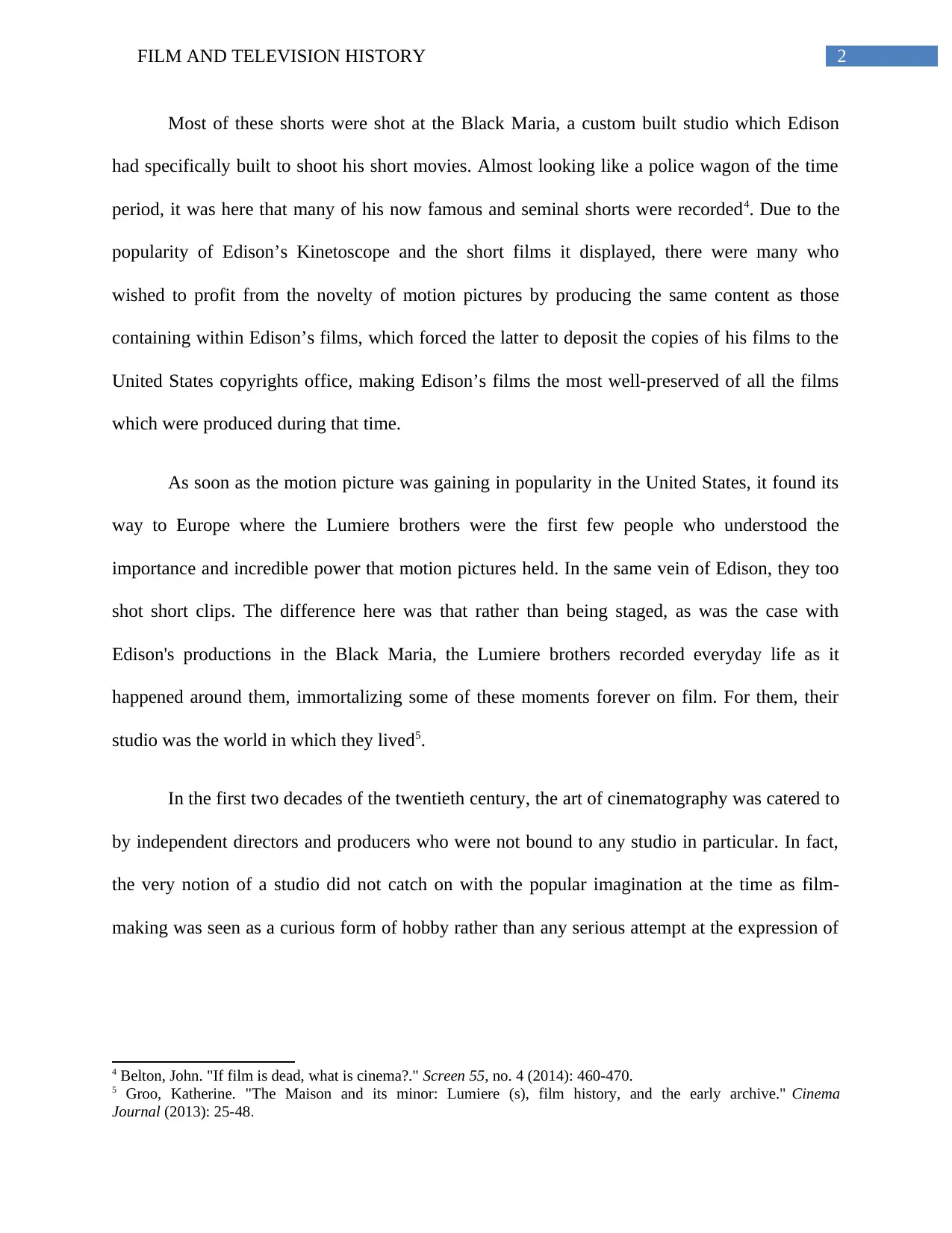
2FILM AND TELEVISION HISTORY
Most of these shorts were shot at the Black Maria, a custom built studio which Edison
had specifically built to shoot his short movies. Almost looking like a police wagon of the time
period, it was here that many of his now famous and seminal shorts were recorded4. Due to the
popularity of Edison’s Kinetoscope and the short films it displayed, there were many who
wished to profit from the novelty of motion pictures by producing the same content as those
containing within Edison’s films, which forced the latter to deposit the copies of his films to the
United States copyrights office, making Edison’s films the most well-preserved of all the films
which were produced during that time.
As soon as the motion picture was gaining in popularity in the United States, it found its
way to Europe where the Lumiere brothers were the first few people who understood the
importance and incredible power that motion pictures held. In the same vein of Edison, they too
shot short clips. The difference here was that rather than being staged, as was the case with
Edison's productions in the Black Maria, the Lumiere brothers recorded everyday life as it
happened around them, immortalizing some of these moments forever on film. For them, their
studio was the world in which they lived5.
In the first two decades of the twentieth century, the art of cinematography was catered to
by independent directors and producers who were not bound to any studio in particular. In fact,
the very notion of a studio did not catch on with the popular imagination at the time as film-
making was seen as a curious form of hobby rather than any serious attempt at the expression of
4 Belton, John. "If film is dead, what is cinema?." Screen 55, no. 4 (2014): 460-470.
5 Groo, Katherine. "The Maison and its minor: Lumiere (s), film history, and the early archive." Cinema
Journal (2013): 25-48.
Most of these shorts were shot at the Black Maria, a custom built studio which Edison
had specifically built to shoot his short movies. Almost looking like a police wagon of the time
period, it was here that many of his now famous and seminal shorts were recorded4. Due to the
popularity of Edison’s Kinetoscope and the short films it displayed, there were many who
wished to profit from the novelty of motion pictures by producing the same content as those
containing within Edison’s films, which forced the latter to deposit the copies of his films to the
United States copyrights office, making Edison’s films the most well-preserved of all the films
which were produced during that time.
As soon as the motion picture was gaining in popularity in the United States, it found its
way to Europe where the Lumiere brothers were the first few people who understood the
importance and incredible power that motion pictures held. In the same vein of Edison, they too
shot short clips. The difference here was that rather than being staged, as was the case with
Edison's productions in the Black Maria, the Lumiere brothers recorded everyday life as it
happened around them, immortalizing some of these moments forever on film. For them, their
studio was the world in which they lived5.
In the first two decades of the twentieth century, the art of cinematography was catered to
by independent directors and producers who were not bound to any studio in particular. In fact,
the very notion of a studio did not catch on with the popular imagination at the time as film-
making was seen as a curious form of hobby rather than any serious attempt at the expression of
4 Belton, John. "If film is dead, what is cinema?." Screen 55, no. 4 (2014): 460-470.
5 Groo, Katherine. "The Maison and its minor: Lumiere (s), film history, and the early archive." Cinema
Journal (2013): 25-48.
⊘ This is a preview!⊘
Do you want full access?
Subscribe today to unlock all pages.

Trusted by 1+ million students worldwide
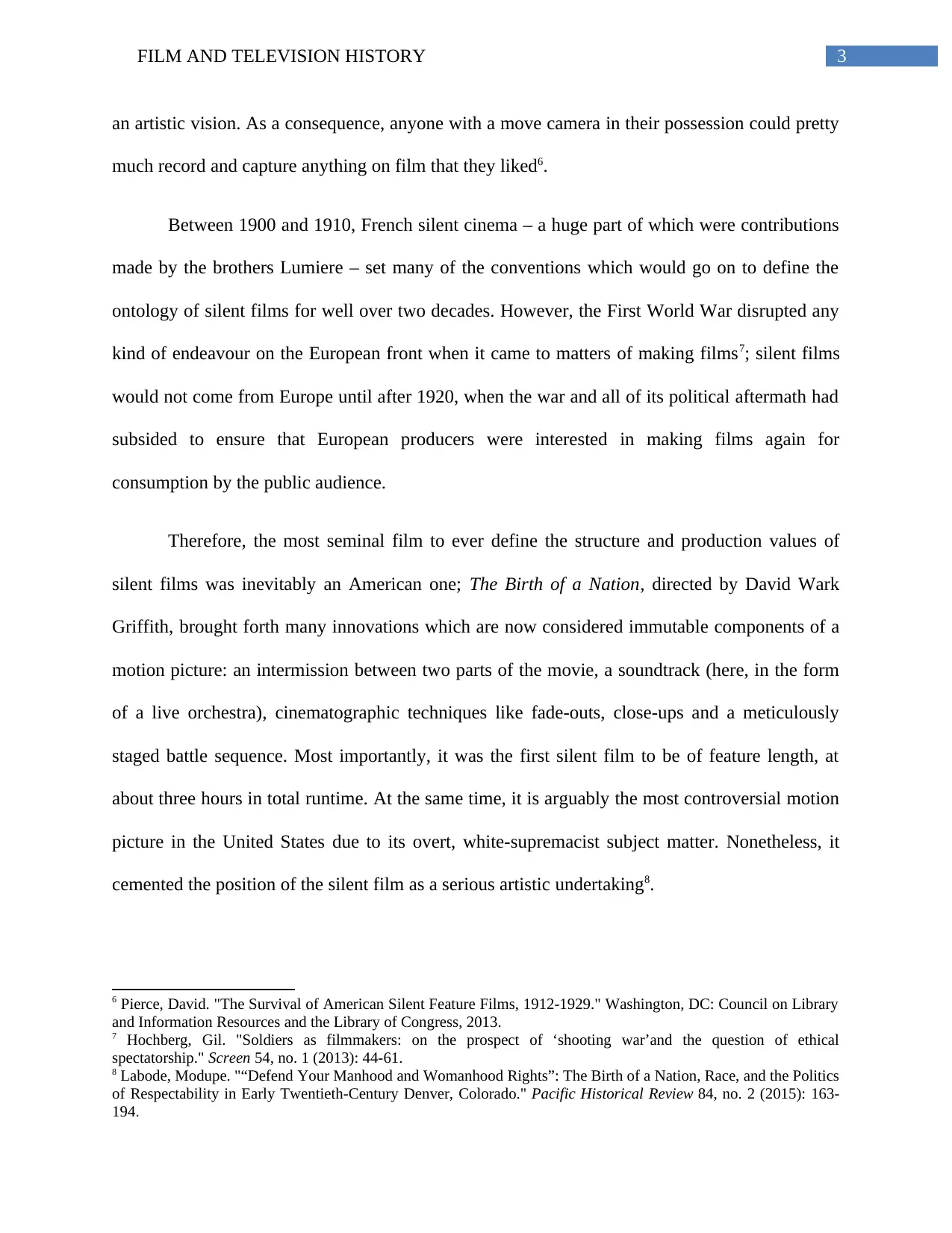
3FILM AND TELEVISION HISTORY
an artistic vision. As a consequence, anyone with a move camera in their possession could pretty
much record and capture anything on film that they liked6.
Between 1900 and 1910, French silent cinema – a huge part of which were contributions
made by the brothers Lumiere – set many of the conventions which would go on to define the
ontology of silent films for well over two decades. However, the First World War disrupted any
kind of endeavour on the European front when it came to matters of making films7; silent films
would not come from Europe until after 1920, when the war and all of its political aftermath had
subsided to ensure that European producers were interested in making films again for
consumption by the public audience.
Therefore, the most seminal film to ever define the structure and production values of
silent films was inevitably an American one; The Birth of a Nation, directed by David Wark
Griffith, brought forth many innovations which are now considered immutable components of a
motion picture: an intermission between two parts of the movie, a soundtrack (here, in the form
of a live orchestra), cinematographic techniques like fade-outs, close-ups and a meticulously
staged battle sequence. Most importantly, it was the first silent film to be of feature length, at
about three hours in total runtime. At the same time, it is arguably the most controversial motion
picture in the United States due to its overt, white-supremacist subject matter. Nonetheless, it
cemented the position of the silent film as a serious artistic undertaking8.
6 Pierce, David. "The Survival of American Silent Feature Films, 1912-1929." Washington, DC: Council on Library
and Information Resources and the Library of Congress, 2013.
7 Hochberg, Gil. "Soldiers as filmmakers: on the prospect of ‘shooting war’and the question of ethical
spectatorship." Screen 54, no. 1 (2013): 44-61.
8 Labode, Modupe. "“Defend Your Manhood and Womanhood Rights”: The Birth of a Nation, Race, and the Politics
of Respectability in Early Twentieth-Century Denver, Colorado." Pacific Historical Review 84, no. 2 (2015): 163-
194.
an artistic vision. As a consequence, anyone with a move camera in their possession could pretty
much record and capture anything on film that they liked6.
Between 1900 and 1910, French silent cinema – a huge part of which were contributions
made by the brothers Lumiere – set many of the conventions which would go on to define the
ontology of silent films for well over two decades. However, the First World War disrupted any
kind of endeavour on the European front when it came to matters of making films7; silent films
would not come from Europe until after 1920, when the war and all of its political aftermath had
subsided to ensure that European producers were interested in making films again for
consumption by the public audience.
Therefore, the most seminal film to ever define the structure and production values of
silent films was inevitably an American one; The Birth of a Nation, directed by David Wark
Griffith, brought forth many innovations which are now considered immutable components of a
motion picture: an intermission between two parts of the movie, a soundtrack (here, in the form
of a live orchestra), cinematographic techniques like fade-outs, close-ups and a meticulously
staged battle sequence. Most importantly, it was the first silent film to be of feature length, at
about three hours in total runtime. At the same time, it is arguably the most controversial motion
picture in the United States due to its overt, white-supremacist subject matter. Nonetheless, it
cemented the position of the silent film as a serious artistic undertaking8.
6 Pierce, David. "The Survival of American Silent Feature Films, 1912-1929." Washington, DC: Council on Library
and Information Resources and the Library of Congress, 2013.
7 Hochberg, Gil. "Soldiers as filmmakers: on the prospect of ‘shooting war’and the question of ethical
spectatorship." Screen 54, no. 1 (2013): 44-61.
8 Labode, Modupe. "“Defend Your Manhood and Womanhood Rights”: The Birth of a Nation, Race, and the Politics
of Respectability in Early Twentieth-Century Denver, Colorado." Pacific Historical Review 84, no. 2 (2015): 163-
194.
Paraphrase This Document
Need a fresh take? Get an instant paraphrase of this document with our AI Paraphraser
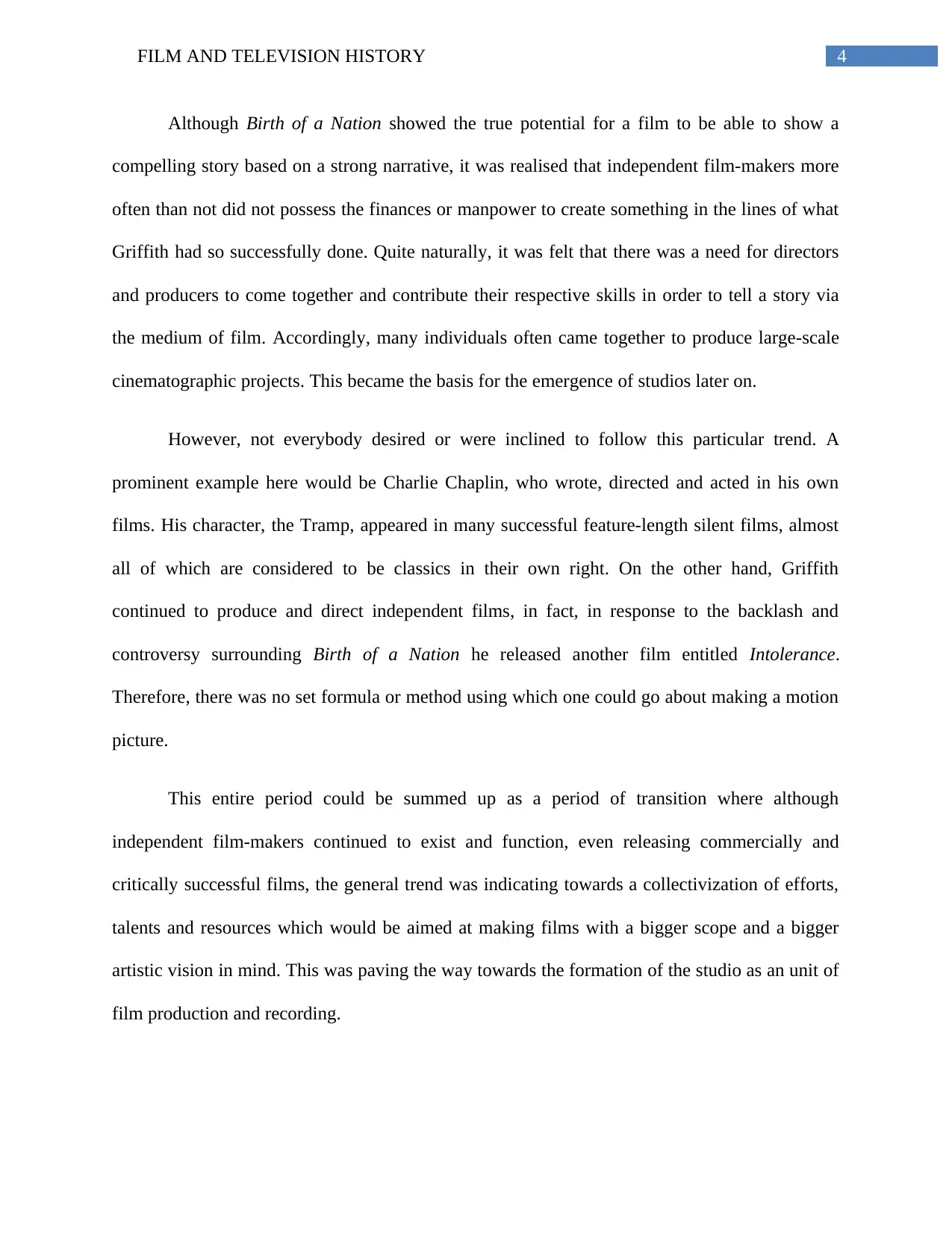
4FILM AND TELEVISION HISTORY
Although Birth of a Nation showed the true potential for a film to be able to show a
compelling story based on a strong narrative, it was realised that independent film-makers more
often than not did not possess the finances or manpower to create something in the lines of what
Griffith had so successfully done. Quite naturally, it was felt that there was a need for directors
and producers to come together and contribute their respective skills in order to tell a story via
the medium of film. Accordingly, many individuals often came together to produce large-scale
cinematographic projects. This became the basis for the emergence of studios later on.
However, not everybody desired or were inclined to follow this particular trend. A
prominent example here would be Charlie Chaplin, who wrote, directed and acted in his own
films. His character, the Tramp, appeared in many successful feature-length silent films, almost
all of which are considered to be classics in their own right. On the other hand, Griffith
continued to produce and direct independent films, in fact, in response to the backlash and
controversy surrounding Birth of a Nation he released another film entitled Intolerance.
Therefore, there was no set formula or method using which one could go about making a motion
picture.
This entire period could be summed up as a period of transition where although
independent film-makers continued to exist and function, even releasing commercially and
critically successful films, the general trend was indicating towards a collectivization of efforts,
talents and resources which would be aimed at making films with a bigger scope and a bigger
artistic vision in mind. This was paving the way towards the formation of the studio as an unit of
film production and recording.
Although Birth of a Nation showed the true potential for a film to be able to show a
compelling story based on a strong narrative, it was realised that independent film-makers more
often than not did not possess the finances or manpower to create something in the lines of what
Griffith had so successfully done. Quite naturally, it was felt that there was a need for directors
and producers to come together and contribute their respective skills in order to tell a story via
the medium of film. Accordingly, many individuals often came together to produce large-scale
cinematographic projects. This became the basis for the emergence of studios later on.
However, not everybody desired or were inclined to follow this particular trend. A
prominent example here would be Charlie Chaplin, who wrote, directed and acted in his own
films. His character, the Tramp, appeared in many successful feature-length silent films, almost
all of which are considered to be classics in their own right. On the other hand, Griffith
continued to produce and direct independent films, in fact, in response to the backlash and
controversy surrounding Birth of a Nation he released another film entitled Intolerance.
Therefore, there was no set formula or method using which one could go about making a motion
picture.
This entire period could be summed up as a period of transition where although
independent film-makers continued to exist and function, even releasing commercially and
critically successful films, the general trend was indicating towards a collectivization of efforts,
talents and resources which would be aimed at making films with a bigger scope and a bigger
artistic vision in mind. This was paving the way towards the formation of the studio as an unit of
film production and recording.
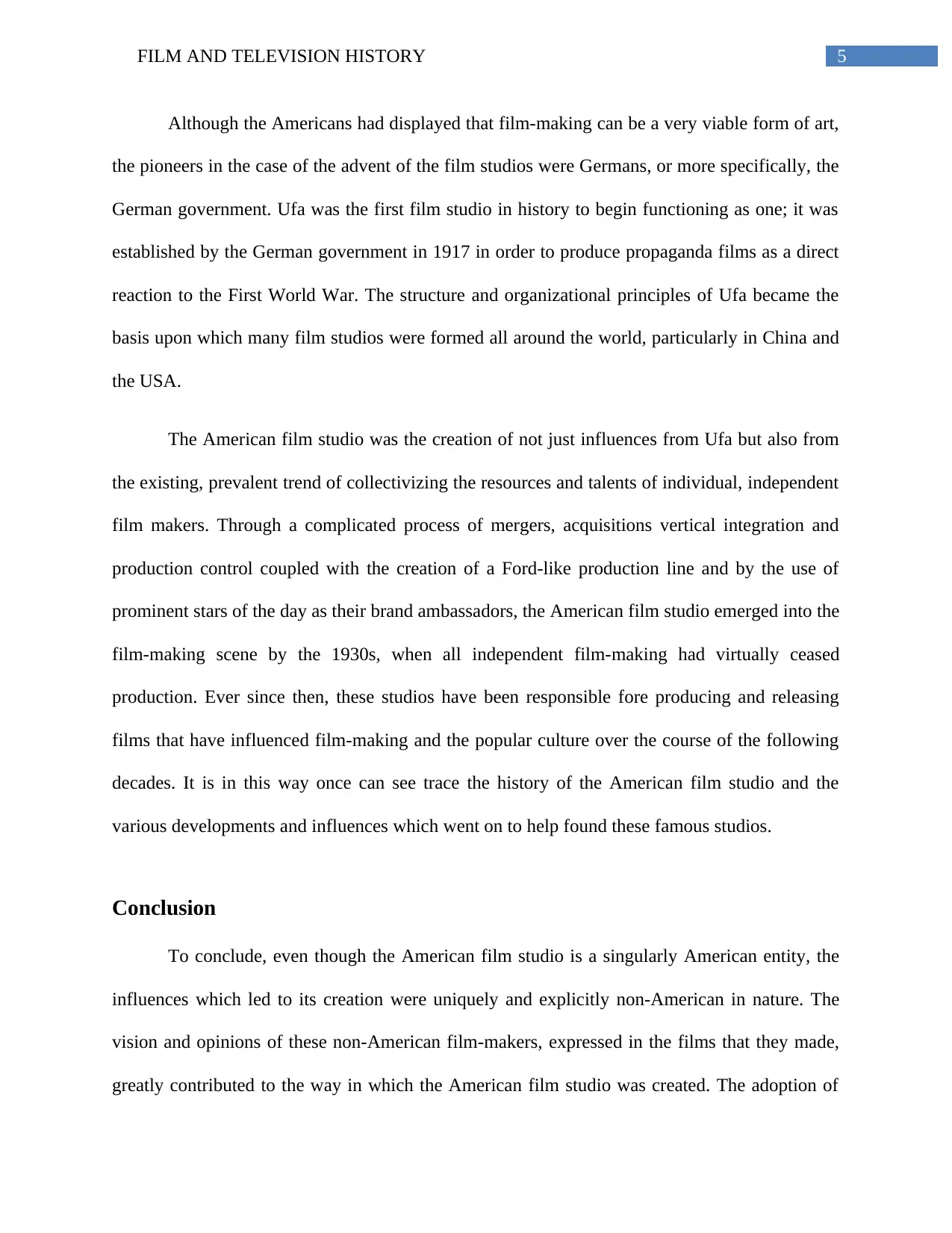
5FILM AND TELEVISION HISTORY
Although the Americans had displayed that film-making can be a very viable form of art,
the pioneers in the case of the advent of the film studios were Germans, or more specifically, the
German government. Ufa was the first film studio in history to begin functioning as one; it was
established by the German government in 1917 in order to produce propaganda films as a direct
reaction to the First World War. The structure and organizational principles of Ufa became the
basis upon which many film studios were formed all around the world, particularly in China and
the USA.
The American film studio was the creation of not just influences from Ufa but also from
the existing, prevalent trend of collectivizing the resources and talents of individual, independent
film makers. Through a complicated process of mergers, acquisitions vertical integration and
production control coupled with the creation of a Ford-like production line and by the use of
prominent stars of the day as their brand ambassadors, the American film studio emerged into the
film-making scene by the 1930s, when all independent film-making had virtually ceased
production. Ever since then, these studios have been responsible fore producing and releasing
films that have influenced film-making and the popular culture over the course of the following
decades. It is in this way once can see trace the history of the American film studio and the
various developments and influences which went on to help found these famous studios.
Conclusion
To conclude, even though the American film studio is a singularly American entity, the
influences which led to its creation were uniquely and explicitly non-American in nature. The
vision and opinions of these non-American film-makers, expressed in the films that they made,
greatly contributed to the way in which the American film studio was created. The adoption of
Although the Americans had displayed that film-making can be a very viable form of art,
the pioneers in the case of the advent of the film studios were Germans, or more specifically, the
German government. Ufa was the first film studio in history to begin functioning as one; it was
established by the German government in 1917 in order to produce propaganda films as a direct
reaction to the First World War. The structure and organizational principles of Ufa became the
basis upon which many film studios were formed all around the world, particularly in China and
the USA.
The American film studio was the creation of not just influences from Ufa but also from
the existing, prevalent trend of collectivizing the resources and talents of individual, independent
film makers. Through a complicated process of mergers, acquisitions vertical integration and
production control coupled with the creation of a Ford-like production line and by the use of
prominent stars of the day as their brand ambassadors, the American film studio emerged into the
film-making scene by the 1930s, when all independent film-making had virtually ceased
production. Ever since then, these studios have been responsible fore producing and releasing
films that have influenced film-making and the popular culture over the course of the following
decades. It is in this way once can see trace the history of the American film studio and the
various developments and influences which went on to help found these famous studios.
Conclusion
To conclude, even though the American film studio is a singularly American entity, the
influences which led to its creation were uniquely and explicitly non-American in nature. The
vision and opinions of these non-American film-makers, expressed in the films that they made,
greatly contributed to the way in which the American film studio was created. The adoption of
⊘ This is a preview!⊘
Do you want full access?
Subscribe today to unlock all pages.

Trusted by 1+ million students worldwide
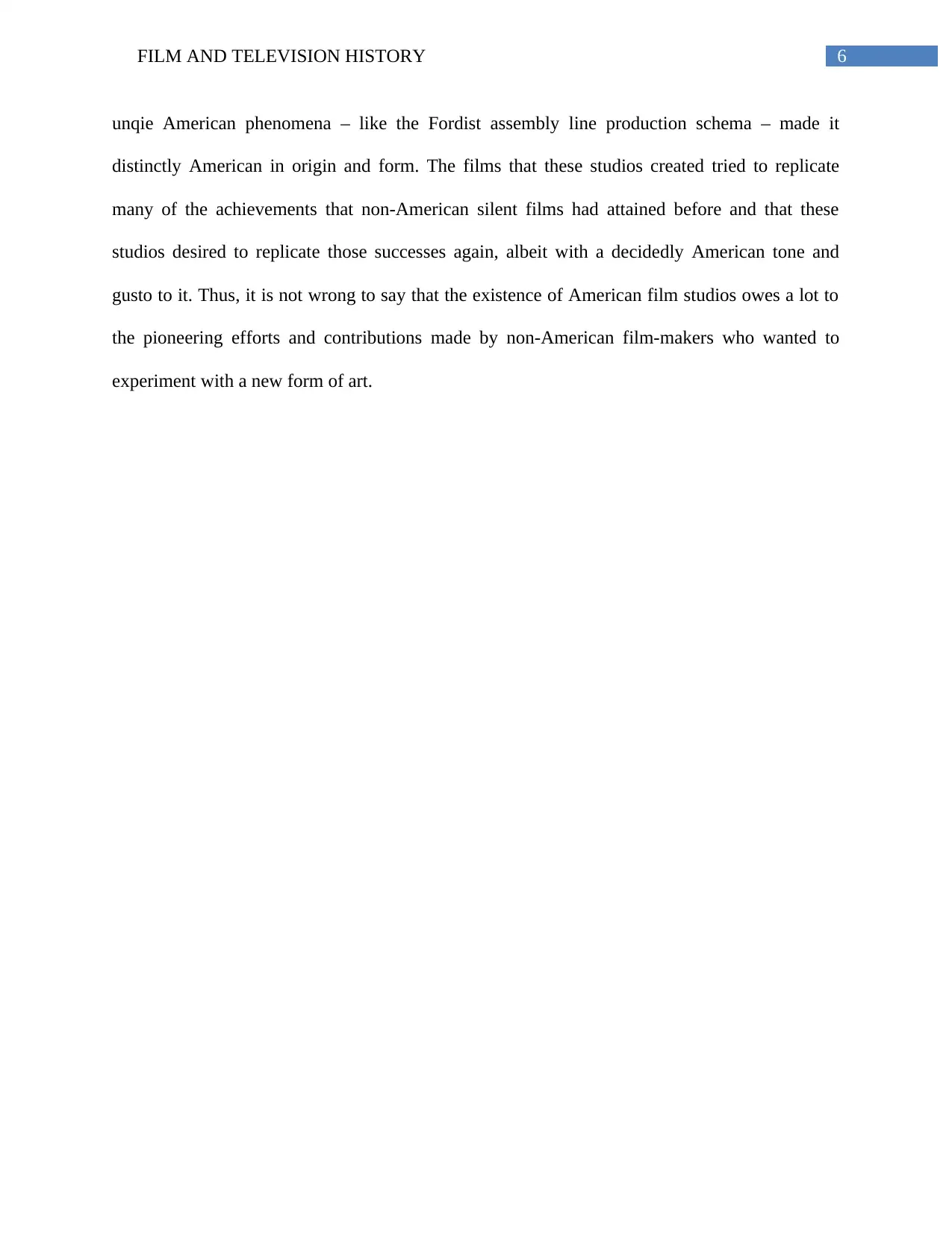
6FILM AND TELEVISION HISTORY
unqie American phenomena – like the Fordist assembly line production schema – made it
distinctly American in origin and form. The films that these studios created tried to replicate
many of the achievements that non-American silent films had attained before and that these
studios desired to replicate those successes again, albeit with a decidedly American tone and
gusto to it. Thus, it is not wrong to say that the existence of American film studios owes a lot to
the pioneering efforts and contributions made by non-American film-makers who wanted to
experiment with a new form of art.
unqie American phenomena – like the Fordist assembly line production schema – made it
distinctly American in origin and form. The films that these studios created tried to replicate
many of the achievements that non-American silent films had attained before and that these
studios desired to replicate those successes again, albeit with a decidedly American tone and
gusto to it. Thus, it is not wrong to say that the existence of American film studios owes a lot to
the pioneering efforts and contributions made by non-American film-makers who wanted to
experiment with a new form of art.
Paraphrase This Document
Need a fresh take? Get an instant paraphrase of this document with our AI Paraphraser
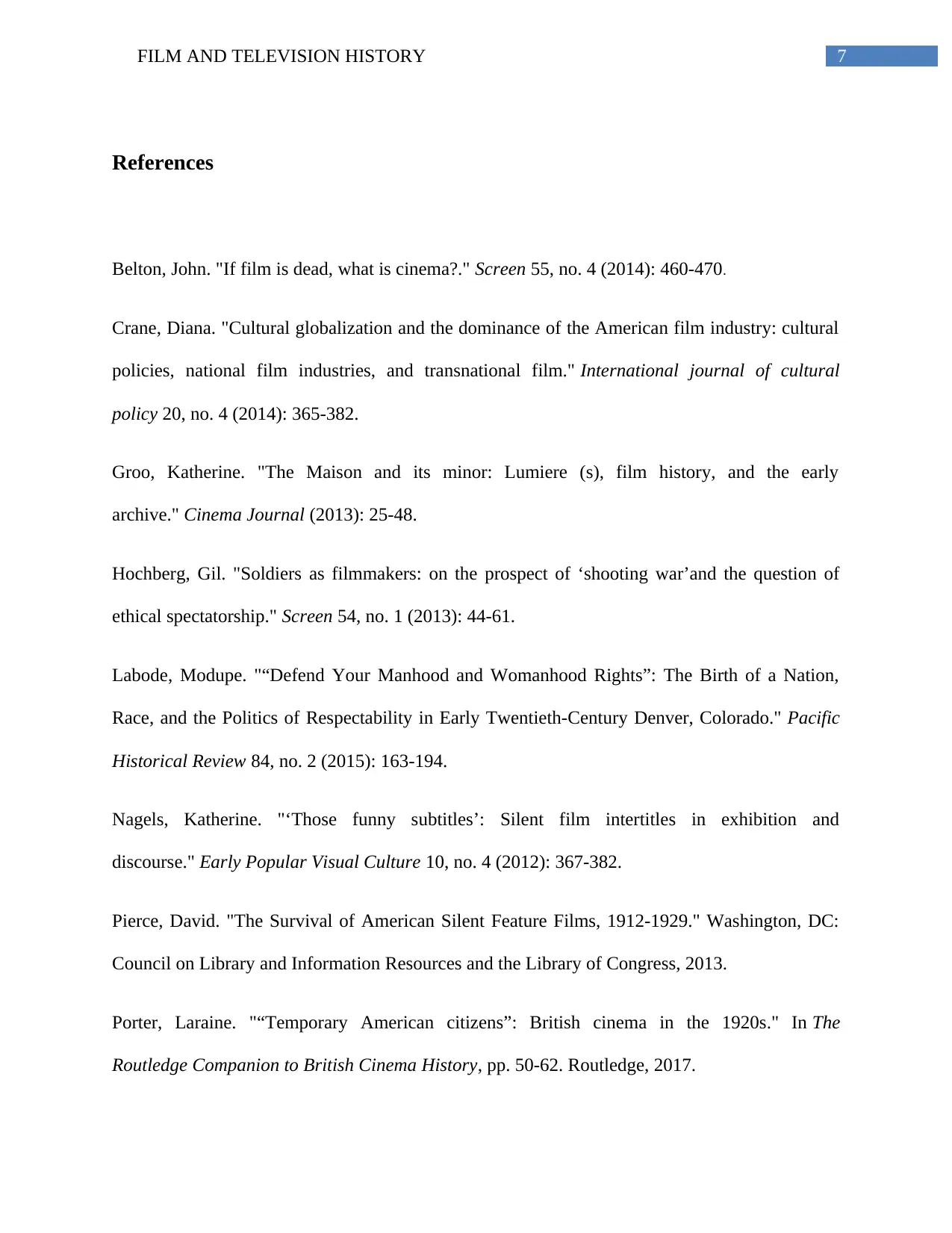
7FILM AND TELEVISION HISTORY
References
Belton, John. "If film is dead, what is cinema?." Screen 55, no. 4 (2014): 460-470.
Crane, Diana. "Cultural globalization and the dominance of the American film industry: cultural
policies, national film industries, and transnational film." International journal of cultural
policy 20, no. 4 (2014): 365-382.
Groo, Katherine. "The Maison and its minor: Lumiere (s), film history, and the early
archive." Cinema Journal (2013): 25-48.
Hochberg, Gil. "Soldiers as filmmakers: on the prospect of ‘shooting war’and the question of
ethical spectatorship." Screen 54, no. 1 (2013): 44-61.
Labode, Modupe. "“Defend Your Manhood and Womanhood Rights”: The Birth of a Nation,
Race, and the Politics of Respectability in Early Twentieth-Century Denver, Colorado." Pacific
Historical Review 84, no. 2 (2015): 163-194.
Nagels, Katherine. "‘Those funny subtitles’: Silent film intertitles in exhibition and
discourse." Early Popular Visual Culture 10, no. 4 (2012): 367-382.
Pierce, David. "The Survival of American Silent Feature Films, 1912-1929." Washington, DC:
Council on Library and Information Resources and the Library of Congress, 2013.
Porter, Laraine. "“Temporary American citizens”: British cinema in the 1920s." In The
Routledge Companion to British Cinema History, pp. 50-62. Routledge, 2017.
References
Belton, John. "If film is dead, what is cinema?." Screen 55, no. 4 (2014): 460-470.
Crane, Diana. "Cultural globalization and the dominance of the American film industry: cultural
policies, national film industries, and transnational film." International journal of cultural
policy 20, no. 4 (2014): 365-382.
Groo, Katherine. "The Maison and its minor: Lumiere (s), film history, and the early
archive." Cinema Journal (2013): 25-48.
Hochberg, Gil. "Soldiers as filmmakers: on the prospect of ‘shooting war’and the question of
ethical spectatorship." Screen 54, no. 1 (2013): 44-61.
Labode, Modupe. "“Defend Your Manhood and Womanhood Rights”: The Birth of a Nation,
Race, and the Politics of Respectability in Early Twentieth-Century Denver, Colorado." Pacific
Historical Review 84, no. 2 (2015): 163-194.
Nagels, Katherine. "‘Those funny subtitles’: Silent film intertitles in exhibition and
discourse." Early Popular Visual Culture 10, no. 4 (2012): 367-382.
Pierce, David. "The Survival of American Silent Feature Films, 1912-1929." Washington, DC:
Council on Library and Information Resources and the Library of Congress, 2013.
Porter, Laraine. "“Temporary American citizens”: British cinema in the 1920s." In The
Routledge Companion to British Cinema History, pp. 50-62. Routledge, 2017.

8FILM AND TELEVISION HISTORY
⊘ This is a preview!⊘
Do you want full access?
Subscribe today to unlock all pages.

Trusted by 1+ million students worldwide
1 out of 9
Related Documents
Your All-in-One AI-Powered Toolkit for Academic Success.
+13062052269
info@desklib.com
Available 24*7 on WhatsApp / Email
![[object Object]](/_next/static/media/star-bottom.7253800d.svg)
Unlock your academic potential
Copyright © 2020–2025 A2Z Services. All Rights Reserved. Developed and managed by ZUCOL.





